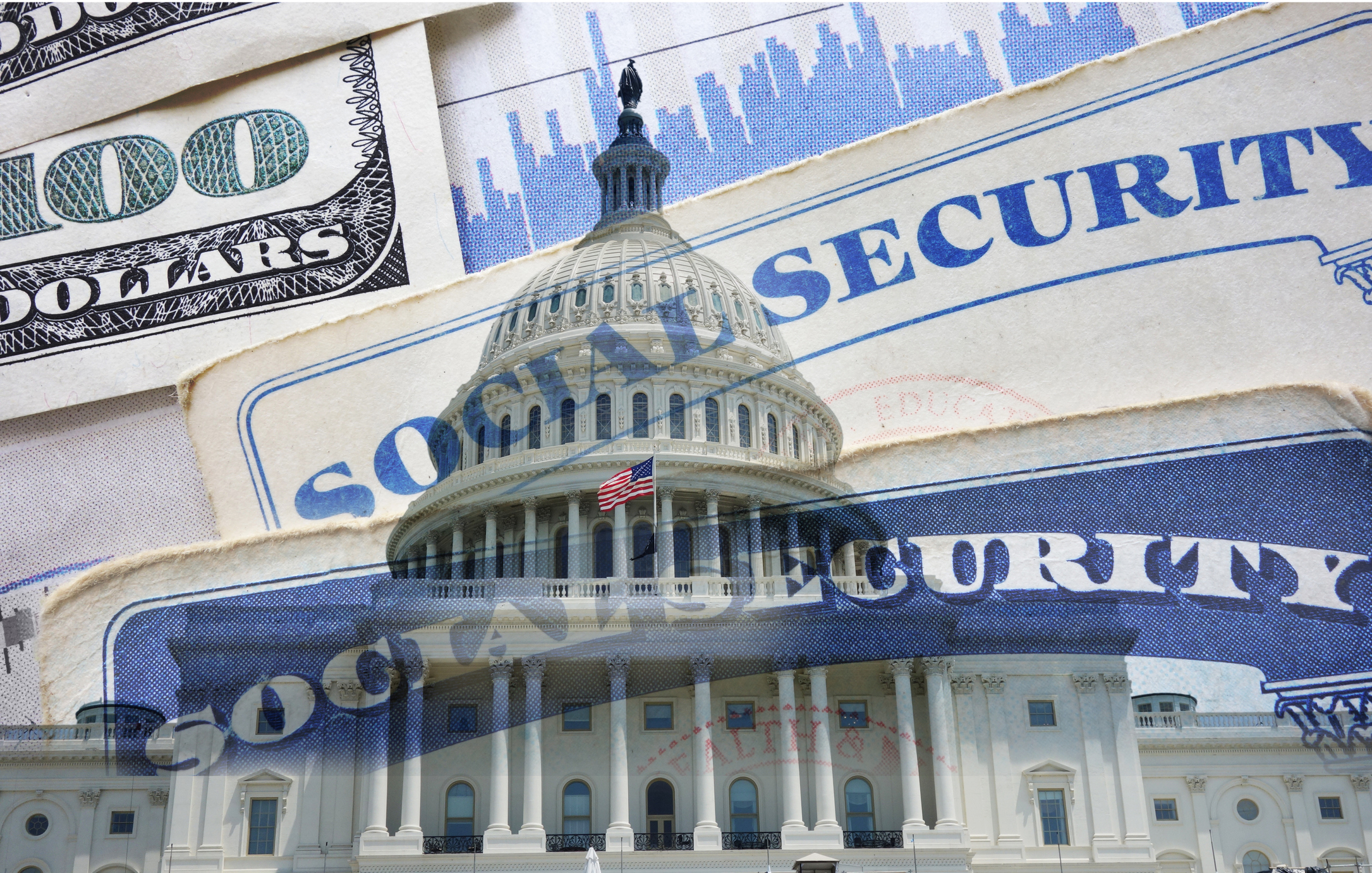What Trump Has Done With Social Security So Far
In Trump's first 100 days in office, he has proposed or initiated changes to how Social Security functions, including closing offices and offering buyouts. Here's an updated roundup.


In the first 100 days of Trump's second presidency, he has outlined and implemented, at least in part, an ambitious agenda, including several key changes to Social Security. But, whether or not you voted for him, you will want to stay tuned in to the latest updates, especially in terms of how they will affect your finances.
During his joint address to Congress this past March, President Trump covered a wide range of topics and outlined his plans for the next four years, including investigating what he said was fraud and waste within the Social Security program.
In 2025, about 73 million Americans will receive Social Security, Supplemental Security Income (SSI), or both, according to the Social Security Administration, with nearly $1.6 trillion in benefits paid out annually. Trump's agenda could directly impact Social Security, a significant source of income for most people over age 65. However, the program is on shaky ground and may need to reduce benefits in ten years if Congress doesn't make changes to bolster its finances.

Sign up for Kiplinger’s Free E-Newsletters
Profit and prosper with the best of expert advice on investing, taxes, retirement, personal finance and more - straight to your e-mail.
Profit and prosper with the best of expert advice - straight to your e-mail.
Although it's still early, here’s what Trump has done with Social Security so far. (A separate story looks at what Trump has done with Medicare so far).
Trump names new Deputy Commissioner of Office Operations at the SSA
On Friday, April 25th, the Social Security Administration (SSA) announced the appointment of Stephen Evangelista as the Deputy Commissioner for the Office of Operations. In this role, Evangelista will oversee the SSA’s customer support services, which includes oversight of more than 1,200 field offices nationwide, as well as 23 teleservice centers that provide assistance over the phone.
Evangelista has over 25 years of experience in executive leadership roles at SSA, most recently serving as the Assistant Deputy Commissioner for Policy in the Office of Law and Policy.
“Stephen’s proven track record of leadership and his dedication to public service make him an excellent choice for this critical role,” said Lee Dudek, Acting Commissioner of Social Security. “His deep knowledge of the agency’s programs will be an asset as we continue to improve customer service while safeguarding Americans’ hard-earned benefits.”
Read: Social Security Phone Wait Times: The Best Times to Call
Trump signs memo stating non-citizens ineligible for Social Security benefits
President Trump signed a memorandum directing the Social Security Administration to take steps to ensure non-citizens who are ineligible for benefits don’t receive any from the SSA. These actions include:
- Expand the SSA’s fraud prosecutor programs
- Investigate earnings reports of people 100 years old or older with mismatched records
- Evaluate reinstatement of SSA’s civil monetary penalty program
The memo states that all non-citizens who have authorization to work in the U.S. must pay all of the existing Social Security and Medicare taxes, and may be able to draw benefits from those systems if they meet the eligibility requirements. In addition to other factors, permanent residents that are non-citizens have a 5-year residency requirement to access Medicare.
Read: Return to Your Home Country to Retire: Repatriation Retirement
If you have student loan debt in default, your SS checks may be at risk.
Beginning next Monday, May 5, the Department of Education will restart collections of defaulted federal student loans via the Treasury Offset Program that collects delinquent debts owed to the government by withholding tax refunds and Social Security benefits. After 30 days, it can start going after your paycheck.
“Borrowers who don’t make payments on time will see their credit scores go down, and in some cases their wages automatically garnished,” wrote Education Secretary Linda McMahon in an opinion piece for the Wall Street Journal.
Within the next two weeks, affected borrowers should hear from the Office of Federal Student Aid. If you are in default, the Education Department urges you to contact the Debt Resolution website to make a payment, enroll in an income-driven repayment plan, or sign up for loan rehabilitation.
Read: Social Security New Rule: Overpayments Must Be Paid Back 100%. Why It Matters
Trump reinstates National Social Security month
First introduced in 2019 during President Trump’s first administration, National Social Security month has been reinstated. In 2025, the awareness month will run from April through August 14, when Social Security celebrates its 90th Anniversary. National Social Security Month is a public awareness campaign held in April each year that is dedicated to helping Americans access their benefits. It was canceled during COVID-19 and did not resume under former President Biden. "This year’s enhanced public outreach to help eligible individuals access their benefits continues Social Security’s proud tradition of service to the American people," states the SSA April 22 press release.
Read: Americans Optimistic About Future Social Security Benefits
Trump taps Fiserv CEO Frank Bisignano as the new Social Security Administration (SSA) commissioner
On April 2nd, the U.S. Senate Finance Committee advanced the nomination of Fiserv CEO Frank Bisignano to be Commissioner of the Social Security Administration (SSA) by a vote of 14-13. He now awaits scheduling of the final vote.
If confirmed, he will inherit an agency that has undergone numerous changes in Trump's first 100 days, including those made by the Department of Government Efficiency (DOGE), that it says are focused on removing fraud, waste and abuse from Social Security.
During his confirmation hearing, Bisignano told senators he had ‘not thought about’ privatizing Social Security. He also said that Trump had said that Social Security benefits would not be cut under his administration, a plan he supports.
Read: Social Security Under Trump: Live Updates to Keep You Up to Date
mySocial Security log-in to change
Last July, we reported that Social Security online users had to create Login.gov accounts if they don't already have them. Just last month, the Social Security Administration (SSA) reiterated the need to create a secure Login.gov account, posting new information about a change to existing user accounts: “Later this year, the “Sign in with Social Security Username” option will be removed, so it's important you act right away.”
Read: Social Security Login Changes Taking Effect Soon
Trump implements the Social Security Fairness Act
The Social Security Administration will begin paying retroactive benefits and increase monthly benefit payments to over 3.2 million individuals whose benefits were affected by the Windfall Elimination Provision (WEP) and Government Pension Offset (GPO). If you are a public sector employee whose Social Security benefits were reduced or eliminated by the Windfall Elimination Provision (WEP) and/or Government Pension Offset (GPO, your April check should be bigger than last month’s benefit.
“Social Security’s aggressive schedule to start issuing retroactive payments in February and increase monthly benefit payments in April, supports President Trump’s implementation of the Social Security Fairness Act,” said Lee Dudek, Acting Commissioner of Social Security. “The agency’s original estimate of taking a year or more now will only apply to complex cases that automation cannot process. The American people deserve their due benefits as quickly as possible.”
Read: Social Security Sent Out Billions in Back Payments This Week. Here's What You Need to Know.
DOGE reduces staffing at the SSA
In the early days of his administration, President Trump signed an executive order creating the Department of Government Efficiency (DOGE) and made Elon Musk a “special government employee.”
In response to DOGE’s inquiries, the Social Security Administration (SSA) has reduced its staffing target to 50,000 employees, down from the current number of around 57,000. It also identified cost savings opportunities in grants, contracts, property and technology. According to the SSA, the total savings are estimated to exceed $800 million in fiscal 2025.
The Social Security Administration (SSA) also walked back plans to make significant reductions to its phone services by eliminating telephone support for claims processing and direct-deposit account transactions. Instead, the agency has decided to proceed with a narrower revision barring direct-deposit changes via phone.
Read: Social Security Administration: DOGE Cannot Make Changes to Benefit Payments
The SSA to close offices
In collaboration with DOGE, President Trump directed the General Services Administration (GSA) to terminate leases on approximately 7,500 federal offices, including those of the Social Security Administration (SSA). (Most of these offices are currently underutilized or closed). However, as the Social Security Administration is already at its lowest staffing level in 25 years, the closures are raising questions about the accessibility of services for beneficiaries.
This is especially troubling since, starting April 14, 2025, individuals can no longer apply for Social Security benefits or make changes to their direct deposit information over the phone. Instead, they will need to stop into a local office or set up a My Social Security account online, both of which could pose challenges for older individuals who may have difficulty accessing local offices or navigating online systems.
Update: The SSA issued a press release, “Correcting the Record about Social Security Office Closings,” to reassure the public that “the agency has not permanently closed or announced the permanent closure of any local field office.”
Read: 47 Local Social Security Offices to Close After DOGE Cuts
Trump doubles down on no tax on Social Security
During his campaign, President Trump wrote on social media, "Seniors should not pay tax on Social Security." He doubled down on that promise during his joint address to Congress. Trump called for no tax on tips, no tax on overtime and no tax on Social Security benefits, emphasizing that reducing waste and fraud would help lower inflation, balance the budget and strengthen the economy — although some states still tax beneficiaries. This bill has not yet been enacted.
If passed, proponents aim for tax relief to start January 1, 2025, affecting 2026 tax filings. But with no law enacted by April 2025, this remains uncertain.
Read: What's Wrong With Trump's Pledge to End Taxes on Social Security Benefits
No more paper Social Security checks
Roughly 456,000 Americans receive paper Social Security checks. However, that's about to end soon. An executive order signed by President Trump this past March mandates that the federal government stop sending paper Social Security checks — effective September 30, 2025. That means that if you currently receive a paper check, you must set up a direct deposit of your payments before that date to avoid disruption in your benefits.
Read: U.S. Treasury to Eliminate Paper Checks: What It Means for Tax Refunds, Social Security
In-person identity verification
Originally scheduled to go into effect on March 31, but postponed due to criticism from advocacy groups, beneficiaries, and congressional representatives, individuals will no longer be able to apply for Social Security benefits or make changes to their direct deposit information over the phone, which started April 14. Instead, they will be required to either use their online "My Social Security" account or go to their nearest Social Security office to verify their identity.
Initiatives to become more transparent
The Social Security Administration is implementing several initiatives that it says will "promote greater transparency and accountability within its customer service department." These initiatives include publishing Social Security challenges and actions taken online, releasing weekly operational report meetings on YouTube and increasing the amount of detail shared with the public on wait times.
Read: The Average Social Security Check for Retirees in Every State
Recovering Social Security overpayments
As of March 27, 2025, the Social Security Administration will withhold 100% of a person's monthly benefit to recover any overpayments made to beneficiaries. Previously, it withheld 10% of monthly benefits until the overpayment was recovered.
But the full withholding of monthly benefits isn't new. This policy was also in place during the Obama and the first Trump administrations. Full clawbacks of overpayments proved difficult or impossible for some beneficiaries to pay, so the SSA took a softer approach in 2024. However, full clawbacks are expected to save the federal government around $7 billion over the next ten years.
Read: Social Security New Rule: Overpayments Must Be Paid Back 100%. Why It Matters
Trump maintains he will not cut Social Security benefits
“The Trump Administration will not cut Social Security, Medicare, or Medicaid benefits,” the White House said in a press release. “President Trump himself has said it (over and over and over again).”
Read: President Trump's Stances on Social Security and Medicare
Trump wants to lower inflation, which will impact COLAs
Lowering inflation can have a positive effect on Cost of Living Adjustments (COLAs) by stabilizing prices. That, in turn, can help maintain the purchasing power of wages. However, recent tariffs proposed by Trump may temporarily raise inflation, complicating the efforts to achieve lower COLAs.
Read: Retirees Get a Raise in Their Social Security Benefits
Trump cracks down on immigration
President Trump issued several executive orders related to the enforcement of immigration across the border. Although just speculation at this point, the current immigration crackdown could potentially reduce labor supply in some industries, such as home health care. These changes could lead to higher prices for some products and higher inflation, affecting Social Security COLAs.
Read: Are Armed IRS Agents Headed to the Border?
Related Content
Get Kiplinger Today newsletter — free
Profit and prosper with the best of Kiplinger's advice on investing, taxes, retirement, personal finance and much more. Delivered daily. Enter your email in the box and click Sign Me Up.

For the past 18+ years, Kathryn has highlighted the humanity in personal finance by shaping stories that identify the opportunities and obstacles in managing a person's finances. All the same, she’ll jump on other equally important topics if needed. Kathryn graduated with a degree in Journalism and lives in Duluth, Minnesota. She joined Kiplinger in 2023 as a contributor.
-
 'The Best Is Yet to Come' — Four Things You Gain in Retirement
'The Best Is Yet to Come' — Four Things You Gain in RetirementRetirement should be a time of exploration, expansion and delight. So if you've done your planning well, enjoy these four retirement perks.
-
 What's Up With the 10-Year Treasury Bond: Four Financial Experts Weigh In
What's Up With the 10-Year Treasury Bond: Four Financial Experts Weigh InA financial professional and three colleagues explain the fluctuations in the 10-year Treasury bond and what investors should do.
-
 What's Up With the 10-Year Treasury Bond: Four Financial Experts Weigh In
What's Up With the 10-Year Treasury Bond: Four Financial Experts Weigh InA financial professional and three colleagues explain the fluctuations in the 10-year Treasury bond and what investors should do.
-
 Thinking About Buying a Boat? 10 Things to Know First
Thinking About Buying a Boat? 10 Things to Know FirstPlanning on buying a boat in retirement? Think of it as a hole in the water you dump money into, says one expert. But it's not all bad.
-
 Time to Spring-Clean Your Finances: A Financial Professional's Four Steps to Tidy Them Up
Time to Spring-Clean Your Finances: A Financial Professional's Four Steps to Tidy Them UpA midyear review of everything from spending to saving, with adjustments as needed, can set you on track to financial security. Plus, don't forget to check in on your workplace benefits.
-
 Is Your Social Security Earnings Record Wrong? Here's How to Fix It
Is Your Social Security Earnings Record Wrong? Here's How to Fix ItYour Social Security benefits are based on your Social Security earnings record. It's important to review your records to avoid having your benefits reduced.
-
 Eight Ways To Save on Your Next Luxury Trip
Eight Ways To Save on Your Next Luxury TripLooking for ways to stretch your retirement dollars? Follow these tips to get a deal on your next vacation.
-
 Donating Complex Assets Doesn't Have to Be Complicated
Donating Complex Assets Doesn't Have to Be ComplicatedIf you're looking to donate less-conventional assets but don't know where to start, this charity executive has answers, such as considering a donor-advised fund (DAF) for its tax benefits and ease of use.
-
 Think a Repeal of the Estate Tax Wouldn't Affect You? Wrong
Think a Repeal of the Estate Tax Wouldn't Affect You? WrongThe wording of any law that repeals or otherwise changes the federal estate tax could have an impact on all of us. Here's what you need to know, courtesy of an estate planning and tax attorney.
-
 In Your 50s? We Need to Talk About Long-Term Care
In Your 50s? We Need to Talk About Long-Term CareMany people don't like thinking about long-term care, but most people will need it. This financial professional recommends planning for these costs as early as possible to avoid stress later.